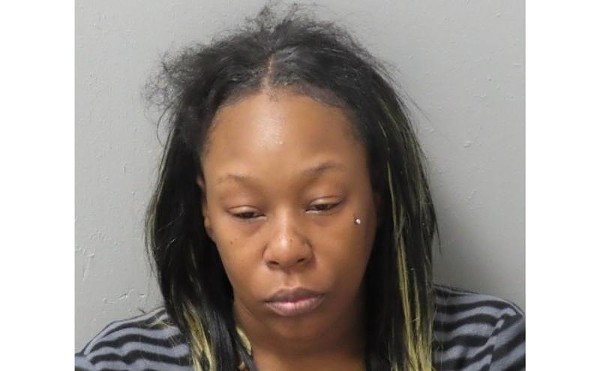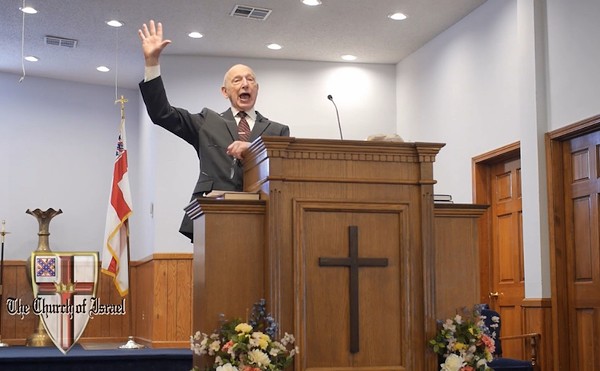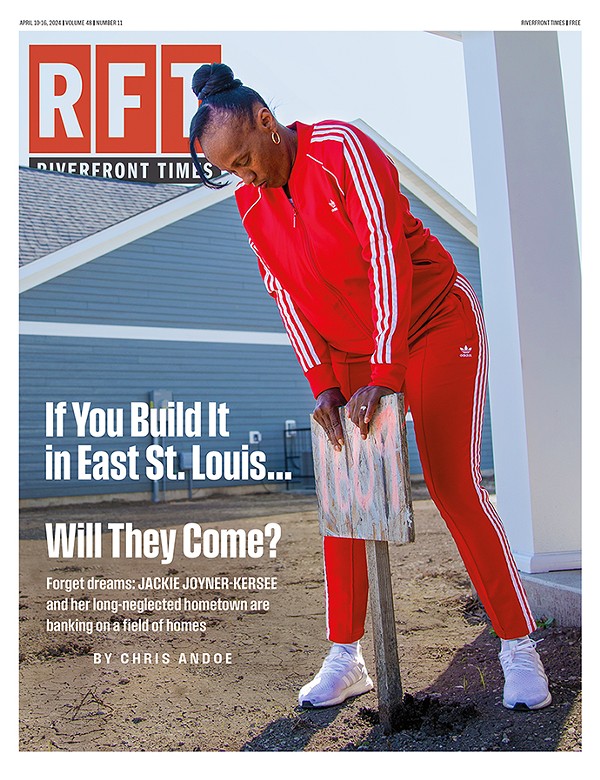So Hickenlooper merits attention. It's just that no one's watching.
Despite working nonstop in the movie business for a decade, Hickenlooper remains what he self-deprecatingly terms "virtually a nonentity in Hollywood." Although known and respected on the film-festival circuit -- his most recent film, The Big Brass Ring, played the prestigious Toronto fest in September and receives a special presentation by the St. Louis International Film Festival on Thursday, Oct. 28 -- Hickenlooper has yet to secure a major theatrical release for any of his movies.
Local cineasts are among the few people who have had an opportunity to see Hickenlooper's films on the big screen: A St. Louis native -- - the city figures peripherally or prominently in most of his movies -- Hickenlooper has screened virtually all of his work in town. But filmgoers elsewhere are familiar with Hickenlooper -- if at all -- through cable-TV showings and tape releases. Most of his films can be found on a well-stocked video store's shelves, but only the most obsessive of movie nerds is likely to be familiar with the entire Hickenlooper oeuvre.
As Hickenlooper succinctly puts the situation: "It's horribly frustrating."
IN AN INTERVIEW WITH THE RFT IN 1991 -- before the Showtime premiere of the work for which he remains best known, the making-of-Apocalypse Now documentary Hearts of Darkness -- Hickenlooper was perhaps all too prophetic when discussing his own future as a maker of serious films: "It's getting a lot harder," he said. "I think it's really grim now. I think audiences are less tolerant of films that make them think." His experience in the following years has done nothing but provide bleak confirmation.
Fresh from the glowing reviews for Hearts of Darkness, Hickenlooper first attempted to set up the film that he only recently completed -- The Big Brass Ring, an unmade Orson Welles script -- but he tripped over the first of the many career hurdles that he's had to clear: "At the time, I was very much pigeonholed as a documentary filmmaker."
The one film Hickenlooper was offered -- "this Civil War vampire script, this B-movie script" -- appeared unpromising, but he was confident he could find an interesting approach to the story. "Since I still very much had Joseph Conrad on the brain from having done Hearts of Darkness," says Hickenlooper, "I thought it would be interesting to create this hybrid of Bram Stoker and Joseph Conrad. The original screenplay had literal vampires with fangs, and they flew around in the sky. I was more interested in a sort of metaphorical vampire, so it became this kind of metaphysical take on vampiricism, very kind of ethereal and atmospheric."
The resulting film -- known originally as The Grey Knight but released to cable as The Killing Box and to video as Ghost Brigade -- never quite rises above its bizarre conceit, and some of the actors seem profoundly uncomfortable in their period getups and unsatisfying vampire makeup. But Hickenlooper demonstrates a fine compositional eye, assembles a typically intriguing cast and coaxes a surprising depthful performance from Corbin Bernsen.
Establishing a pattern that would soon repeat itself, The Grey Knight never played in theaters domestically, although it was released in Europe to what Hickenlooper calls "decent reviews." Adding further insult, the picture was re-edited against Hickenlooper's wishes to remove a strong current of homoeroticism. "Even though I'm a heterosexual," Hickenlooper explains, "I find homoeroticism in art really fascinating, maybe stemming from my Catholic upbringing." According to Hickenlooper, "The producer was kind of freaked out by the homoerotic take on it and he wanted more fangs, so he basically completely recut the picture after I finished it." (Hickenlooper's version of Ghost Brigade is available on the Turner Home Entertainment laserdisc.)
Although he says that "I was at the time very despondent over the recutting," Hickenlooper quickly regrouped and began a new project: a short called "Some Folks Call It a Sling Blade," written by and starring Billy Bob Thornton, with whom he had become friends on The Grey Knight set. "We were sitting in his apartment drinking beers," Hickenlooper says, "and he said, "I want to do this character for you. You'll totally freak out.' I actually left the room, and when I came back in, he was in his character, Karl Childers, and he did this monologue for me about how he killed his mother, and I was riveted. The hair was standing on the back of my neck. I said, "That's amazing. We've got to get this character on film.'"
Together, Thornton and Hickenlooper developed the frame in which the monologue is set -- Karl is interviewed by a reporter on the eve of his release from a mental institution -- and Hickenlooper raised the money for the three-day shoot, casting J.T. Walsh as Karl's creepily insinuating fellow patient and Molly Ringwald as the journalist. The short is an assured, fully realized work, beginning with a long tracking shot of Walsh before the baton of the story is passed first to the reporter and her photographer, then to the asylum's head and, finally, to Karl, who at last relates his terrible and mesmerizing story of matricide.
Despite the success of the collaboration, friction between Thornton and Hickenlooper was developing that would soon produce a conflagration. Hickenlooper remembers: "He and I got into it about how I had shot the monologue. I had shot it two ways -- in closeup, because he asked me to shoot it that way, and as a long tracking shot where you start out wide and slowly dolly in on his face and you slowly pull back from the reporter. Well, we had a light leak on the closeup (making it unusable), but it was never my intention to use a closeup anyway. I thought if we were looking at his monologue in closeup for such an extended period of time, it would start to feel artificial, mannered. I told him, "I didn't raise $55,000 to create a really nice actor's reel for you. This has got to work as a film.' Anyway, we had this huge, fiery argument over this, and, unfortunately, as much as I revere Billy Bob as a writer, he has a very tempestuous personality. So basically we stopped talking to each other."
The pair later reached a temporary truce when the short premiered at the Sundance Film Festival. Buoyed by the positive reception at Sundance, Thornton and Hickenlooper began developing the narrative for what eventually became the feature Sling Blade, but because money for Sling Blade was slow in coming, Hickenlooper redirected his attention to another film, The Low Life, which the director says precipitated the final break between the former friends. Hickenlooper offered Thornton a small part in The Low Life, but the actor lobbied for the role of Andrew, the roommate of the film's protagonist (played by Rory Cochrane). After mulling the idea, Hickenlooper says, "I decided he was just too old for the part. I needed somebody who was Rory Cochrane's contemporary (Thornton is 17 years older than Cochrane). He just flew off the handle and said, "I fucking gave you this short. I gave this to you as a gift, and you throw it back in my face. I'm not going to do any fucking cameos for you.' It just got so ugly." After that episode, Hickenlooper says, "I thought about it for about 48 hours and I called him back and said, "Look, I think we should just end it here. You go your way and I'll go my way.' That was the last time I ever spoke to him."
But, as moviegoers know, those final words were not the end of the story. When Sling Blade finally went into production, Thornton himself was behind the camera. One of the critical hits of 1996, the film earned ecstatic notices, and Thornton received both an Oscar nomination for his performance and an Academy Award for his script. Hickenlooper, needless to say, was not thanked in the acceptance speech. "In retrospect, part of me is sad," Hickenlooper confesses. "What an incredible career move for me had I been able to survive my relationship with him. But in the end I did it for my own sanity. Sure, I would have loved to have done the feature, and had I done the feature, I think it would have been better -- it would have been darker." Hickenlooper, laughing loudly at the thought, then admits, "As a result, it probably wouldn't have won an Oscar, either. I like the feature, but it was a little more schmaltzy than I would have wanted to go."
Hickenlooper carefully emphasizes that he remains an admirer of his former collaborator and says, "I just wish him well. Billy Bob's career is so mainstream now, he's in a totally different world than I am. Who knows? We may end up working together someday. It's Hollywood."
THE FILM Hickenlooper made after "Sling Blade," The Low Life, should rightly have moved its director into the same sphere Thornton now inhabits. A tough, bittersweet comedy with winningly unpredictable tonal and plot shifts, The Low Life evokes the unclassifiable, character-based works of the '70s that Hickenlooper admires (he consciously used Midnight Cowboy, in fact, as a model). Although the original script was written by John Enbom, with whom the director was glancingly familiar from his college days at Yale, Hickenlooper collaborated on a rewrite. The new version incorporated elements of his own autobiography in the character of the film's strangely affectless antihero, a down-at-heels writer from St. Louis now at sea in LA, working dead-end temp jobs by day and drinking with similarly hard-up and unmoored college friends at night. Hickenlooper also added the key character of Andrew -- the part Thornton insisted on playing -- whom he describes as "this kind of dependent geek based on two people I had known." As subtly embodied by Sean Astin, Andrew proves alternately annoying, frightening and heartbreaking: a black-comic joke as guilt-inducing as laugh-getting.
"It was just a great, fun film," Hickenlooper says, but when the shooting ended, the usual troubles began. "Again, it was one of those very painful scenarios," Hickenlooper says. "We premiered it, and it got incredible critical response. All the executives at all the distribution companies loved it, but they said it just wasn't commercial because it had a real downer ending. It played in 12 cities, got great reviews and deserved a much bigger release, but that's the way it went."
During this period in the mid-'90s, Hickenlooper was also slumming in television, pseudonymously directing five episodes of America's Most Wanted, the flatlined ABC medical drama Vital Signs and an Aaron Spelling pilot called Crosstown Traffic. Hickenlooper then picked up another work-for-hire directing gig in 1996 with Persons Unknown, a competent but formulaic HBO thriller whose clichéd script is slightly elevated by an excellent cast including Joe Mantegna, J.T. Walsh and Jon Favreau. Hickenlooper generously assesses the film as "a semisuccessful attempt at making a stylish thriller," but his preferred "funny, ironic" ending was cut by the producer, and he believes that "the movie works more or less until the very end and then kind of falls apart." Like The Grey Knight, Persons Unknown premiered on cable in the U.S. but received a theatrical release in Europe. "It got amazing reviews in England," Hickenlooper says, and was even cited as one of the year's best films by Empire magazine. "Can you believe it?" he asks with a mix of amusement and pride. "The guy must have been on drugs."
Hickenlooper returned to a more personal brand of filmmaking in 1997 with Dogtown, which he both wrote and directed. A look at the constrictive nature of small-town life set in Cuba, Mo. (though shot in Torrance, Calif.), "Dogtown was very much my homage to Peter Bogdanovich and The Last Picture Show," says Hickenlooper, and it allowed the filmmaker to explore in fictional terms territory he had previously covered in Picture This, his documentary on Bogdanovich. Dogtown, like The Low Life, resembles a '70s drama with its quirky, stopped-down rhythms -- it's unafraid to dawdle over small, revealing moments -- and a narrative based more in realistic situations than in genre conventions. Although the film ultimately suffers from its derivative, poor-second-cousin kinship to The Last Picture Show and some reductive yahoo stereotyping, it's dotted with painful moments of verisimilitude and features two beautifully nuanced performances by Mary Stuart Masterson and Favreau.
The film also interestingly amplifies on the autobiographical elements of The Low Life, centering as it does on the homecoming of Phillip (Trevor St. John), a Cuba native who's accorded a star's welcome despite his lack of success as an actor in LA. "I had come back to St. Louis, and I always felt that I was treated a little differently than I had been as a kid," explains Hickenlooper. "I felt like I had become this minor celebrity in St. Louis, and it felt silly to me because I'm virtually a nonentity in Hollywood. I felt, in a way, like a fraud. I wanted to capture that feeling in Dogtown." (Hickenlooper will examine the subject of stardom again in a more expansive form in The Mayor of the Sunset Strip, a documentary he's been shooting for the past two years on celebrity-obsessed LA disc jockey Rodney Bingenheimer.)
With dismaying predictability, however, the ill luck that Hickenlooper first experienced with The Grey Knight returned with Dogtown. "Again, it got amazing reviews at festivals," asserts Hickenlooper, "but the pacing was considered slow and deliberate. Fox Searchlight liked the picture but thought it was too downbeat and didn't have enough octane in it for a theatrical release. One distributor said it was "too Chekhovian.'" Hickenlooper sighs with exasperation: "Dogtown to this day has yet to see any kind of distribution. Since The Big Brass Ring, there has been some interest for taking it out theatrically, so it may yet still have some life. But otherwise it's available in my closet drawer."
GIVEN HICKENLOOPER'S DIFFICULTIES WITH distribution over the past decade, it's ironically appropriate that his most recent feature, The Big Brass Ring, should be adapted from a screenplay by Orson Welles, who was famously shunned and ill-used by Hollywood after making what many consider America's (and the world's) finest film, Citizen Kane. The Big Brass Ring actually serves as something of a coda to Citizen Kane, revisiting the political milieu of that film and reiterating, albeit in diminished and less compelling form, some of its themes: the impact of abandonment, the conflict between public and private lives.
Hickenlooper's movie, which he co-wrote with LA Weekly film critic F.X. Feeney, departs substantially from the Welles script, altering both setting (moving it from Spain and Africa to St. Louis) and story (a presidential defeat becomes a gubernatorial election; a scandal involving an Asian mistress becomes a potentially devastating revelation about a long-lost brother). "The original Welles script is kind of amusing and funny and very gothic," says Hickenlooper. "I thought, "This is an incredible story, but it's a story that only Welles could make because it's so baroque.'" Hickenlooper, however, retains Welles' quartet of main characters and their essential relationships: Blake Pellarin (William Hurt), here an independent candidate for Missouri governor; his mentor (Nigel Hawthorne), a former senator disgraced by revelations of his homosexuality; his wife (Miranda Richardson), a manipulative alcoholic who provides Blake's money and drive; and his journalistic pursuer (Iréne Jacob), who suspects that Blake hides a dark secret beneath his sunny facade.
The film Hickenlooper molded from Welles' clay has fascinating moments, a delightful performance by Hawthorne and an admirable complexity of character and theme, but remains lumpy and at times logically incoherent (the opaque motivations of a sinister aide seem especially implausible). And not only has Hickenlooper failed to discard all of the "gothic" flourishes of the Welles original (a pet monkey, for example), he's added a few of his own devising (most outrageously, a gay riverboat on the St. Louis waterfront).
But whatever the movie's faults, St. Louisans will delight in the director's fresh take on the city. Hickenlooper says he chose St. Louis because it dovetailed so nicely with the film's backstory of two separated brothers (a detail culled from Welles' own life): "I was interested in St. Louis really for metaphorical reasons," Hickenlooper says. "I was dealing with a story about two brothers estranged from each other, and the dynamic of that relationship was something I thought literally played into the dynamics of St. Louis. Here you have a city at the crossroads of two major cultures -- being in the Midwest but being caught between the brazen industrialism of the North and the crazy genteelism of the 19th-century South." It's also clear, however, that Hickenlooper loves St. Louis' unique architectural and geographical qualities, and he makes wonderful use of the riverfront and the Arch. And as for those carnival-like revels on the Mississippi's banks: "Are there any gay riverboats in St. Louis? No, there are no gay riverboats, but, hell, there should be," he jokingly asserts.
Hickenlooper was so pleased by his experience that he intends to set future films here as well. He's hoping to shoot an adaptation of F. Scott Fitzgerald's short story "Winter Dreams" in St. Louis during late spring 2000, and he eventually plans to make a film called The Missouri Compromise, which will complete his trilogy (with The Low Life and Dogtown) about "characters who are artists coming to terms with who they are."
Hickenlooper says, "It is my intention, if I were to be blessed and have a career like Barry Levinson, to do for St. Louis what he did for Baltimore. I do have a lot of stories I want to tell in St. Louis."
THE EVENTUAL SHAPE OF HICKENLOOPER'S career, of course, remains in question. With typical bad fortune, The Big Brass Ring proved another near-miss for theatrical distribution. Although serious interest was evidenced by three distributors, none wanted to pay more than the $2 million offered by Showtime, where the film premiered in August. There's a possibility that the movie will receive a limited release before it debuts on video, but Hickenlooper no longer dwells on it.
Given his experience, Hickenlooper is understandably depressed about the current state of the independent film, and he relates an illustrative anecdote: "Just about a month ago, I was having dinner with Quentin Tarantino and Peter Bogdanovich and Cybill Shepherd" -- a group that, incidentally, belies Hickenlooper's supposed "nonentity" status -- "and Quentin and I were talking about The Last Picture Show and how great it was. And Peter said, "If Picture Show were made today, it wouldn't even get a cable release.' It'd probably end up on video if he was lucky. That's just how the market has changed.
"In the independent-film world today," Hickenlooper continues, "in order to pique anyone's interest, your film has to have some kind of shock value. I'm speaking kind of broadly here, but unless you have lesbian heroin addicts or Siamese twins or some kind of gender-identity switch, distributors aren't going to pick your movie up." Hickenlooper feels little fellowship with his peers: "You've got a group of kids who are making films influenced by comic books," he rails. "It's so patently obvious: comic books and MTV and just basically crap. But the literary establishment, particularly the New York critics, have bought into this kind of kitsch, so kitsch rules.
"That's why I'm retiring from independent filmmaking," Hickenlooper announces. "The Big Brass Ring was kind of my swan song to independent filmmaking." Chuckling ruefully, he adds, "It may be my swan song to filmmaking in general -- I don't know." Hickenlooper, however, is not intending to retreat into a Wellesian exile. Quite the opposite: Deriving hope from such challenging mainstream releases as The Sixth Sense and American Beauty, Hickenlooper is now actively pursuing a more traditional studio path, and he believes his substantial body of work and experience with stars will provide him an entree into the system.
"I don't really see myself going into advertising or going to law school," he says. "I love making films, whether or not they're seen by huge audiences. Of course, it would be nice to be on the radar screen, but I am respected; actors do want to work with me. People will hopefully see these films in time. I go one film at a time."
Like Blake Pellarin, he continues to grasp at the big brass ring.






